If you have a tropical freshwater fish tank, aquarium catfish can make a great addition to your collection!
Freshwater catfish are quirky, fun creatures that inhabit the bottom of the tank where they forage busily through the substrate, eating scraps of food that would otherwise pollute the water. Some small catfish species eat certain species of algae, too, helping to keep the tank tidy and adding an extra level of activity to delight the onlooker.
Read this guide to discover 23 types of aquarium catfish that will make a cute and helpful addition to any peaceful community setup.
15 Catfish Species for Your Aquarium
Now that you know more about catfish and how to care for them let’s introduce you to 15 gorgeous catfish species that can live in your aquarium.
1. Corydoras Catfish
Corydoras catfish are the most common and readily available catfish in the aquarium hobby. These super-cute, active little fish come in over 200 species and make an ideal addition to the community aquarium.
Green or Bronze Corydoras (Corydoras Aeneus)
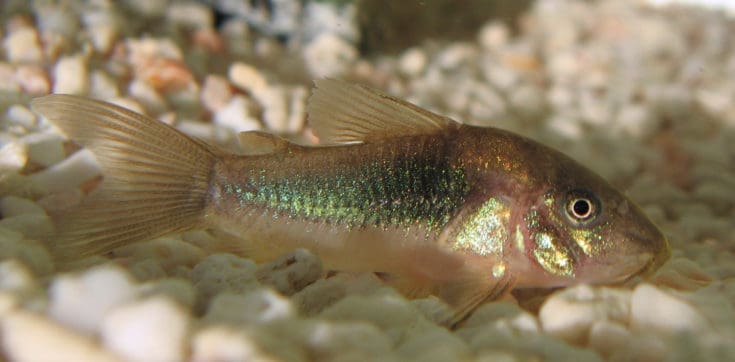
- Maximum size: 2.5 inches
- Minimum tank size: 10 gallons
- Minimum school size: 5
- Water temperature: From 72° to 79° Fahrenheit
- pH: 5.8 to 7.0
- Diet: Omnivore
- Breeding: Egg layer
Green or Bronze Corydoras come from South America, Colombia, and Trinidad to the north and as far south as Uruguay and Argentina. In nature, these sweet little catfish live in shallow, muddy water, where the flow is slow, although they also appear in rivers where the current is faster.
Corydoras catfish have the ability to take gulps of air from the water surface, enabling them to survive in almost stagnant water conditions if they have to. In the home tank, Corys are often seen darting up to the surface to breathe and then diving quickly back down to the substrate.
Peppered Corydoras (Corydoras Paleatus)
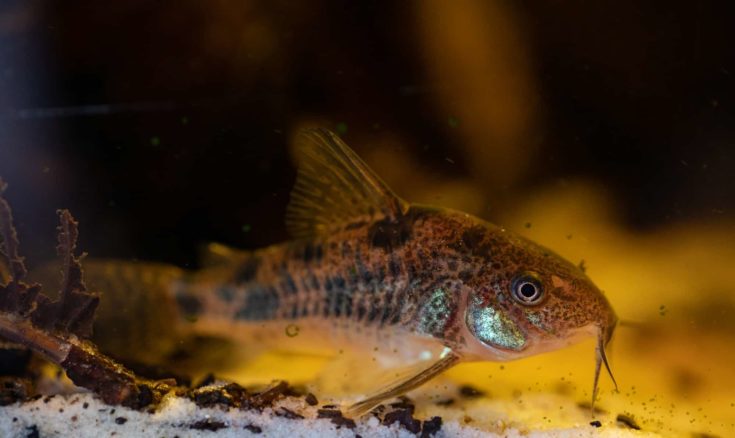
- Maximum size: 2.5 to 3 inches
- Minimum tank size: 10 gallons
- Minimum school size: 5
- Water temperature: From 72° to 79° Fahrenheit
- pH: 5.8 to 7.0
- Diet: Omnivore
- Breeding: Egg layer
Peppered corys are fun freshwater catfish that make fascinating pets that have a habit of “winking” at their owners by tilting one eye down and back up again without moving their head! Also, during courtship, the peppered cory vocalizes. A talking fish – who knew?!
This species of Corydoras catfish was first discovered by Charles Darwin in the 1830s during his exploration of South America and is among the earliest aquarium-kept fish. The first captive-bred Peppered corys were produced in 1878 in France, but these days, most specimens sold in the trade are commercially bred in Asia and Florida.
Pygmy Corydoras (Corydoras pygmaeus)
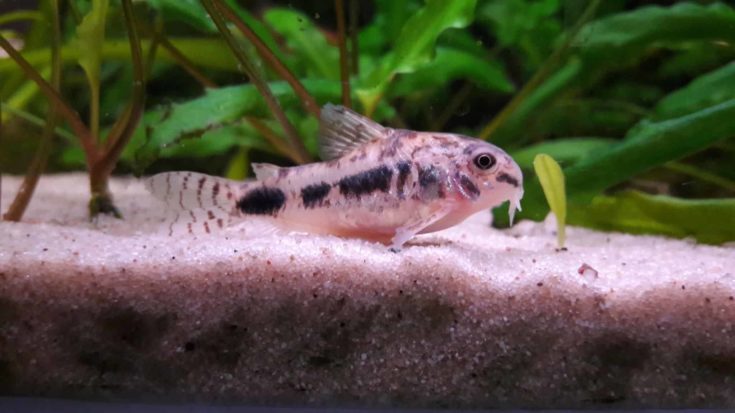
- Maximum size: 1 inch
- Minimum tank size: 10 gallons
- Minimum school size: 8
- Water temperature: From 72° to 79° Fahrenheit
- pH: 6.0 to 7.2
- Diet: Omnivore
- Breeding: Egg layer
The Pygmy corydoras catfish looks very similar to most other varieties of corys, except that these tiny little guys don’t grow larger than just one inch in length. Pygmy corys have a relatively short lifespan or around three years.
These charming, tiny catfish are found in large rivers and their smaller tributaries in South America, specifically the Madeira River in Brazil, the Aguarico River in Ecuador, and the Nany River in Peru. All these locations are tropical; however, the water pH and temperature can vary, which doesn’t affect these tolerant, adaptable little creatures.
The Pygmy cory is an active, shoaling fish that must be kept in a group of at least eight individuals or more. Unlike other bottom-dwelling corydoras, the Pygmy cory spends most of its time swimming in the open midwater area of the tank.
Sterbai Corydoras (Corydoras Sterbai)
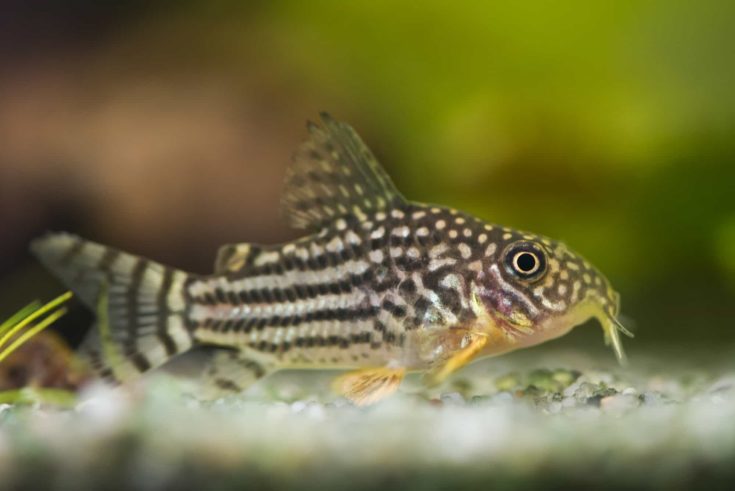
- Maximum size: 2.6 inches
- Minimum tank size: 10 gallons
- Minimum school size: 5
- Water temperature: From 75° to 82° Fahrenheit
- pH: 6.0 to 7.6
- Diet: Omnivore
- Breeding: Egg layer
The Sterbai cory makes an attractive, appealing member of any peaceful community tank. In nature, these fish are a schooling species, so I recommend that you keep them in a group of at least five in an aquarium setting. Generally, the more individuals you have, the more confident and active they are.
Like all corys, Sterbais have extremely sharp pectoral fin spines that are easily snagged in aquarium nets and can inflict a painful injury if they penetrate your skin. If you need to handle your corys, do so with caution.
Orange Laser Corydoras (Corydoras sp. CW010)
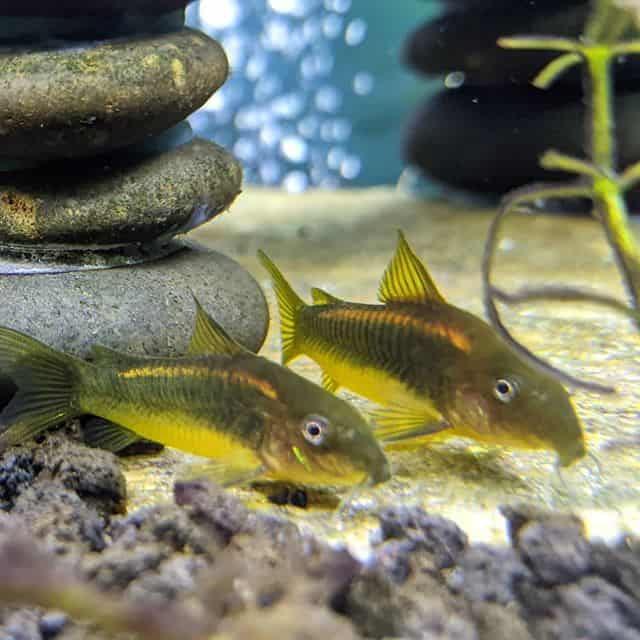
- Maximum size: 2.75 inches
- Minimum tank size: 30 gallons
- Minimum school size: 6
- Water temperature: From 71° to 79° Fahrenheit
- pH: 6.5 to 7.2
- Diet: Omnivore
- Breeding: Egg layer
Orange Laser corydoras are seldom seen in fish stores, although you can buy them online from some dealers. Because of their relative rarity, these corys are quite expensive, often retailing for around $15 per fish.
These corys come from the upper Amazonian rain forest areas of the Upper Amazon, Ucayali, Marañon, Middle Ucayali Rivers, and eastern Peru.
These brightly colored corys are somewhat shyer than their relatives, spending much of their time hiding away during the daytime and venturing out at night to feed. That said, if you keep a group of several individuals, you may find them more confident and active in the day.
2. Synodontis Catfish
Synodontis catfish are natives of Africa. Some species of Synodontis can swim upside down to take food from the underside of overhangs or from the water surface. Also, these fish are often called “squeakers” because they can make a squeaking noise with the bones in their pectoral fins when frightened or threatened.
Clown Synodontis (Synodontis decorus)
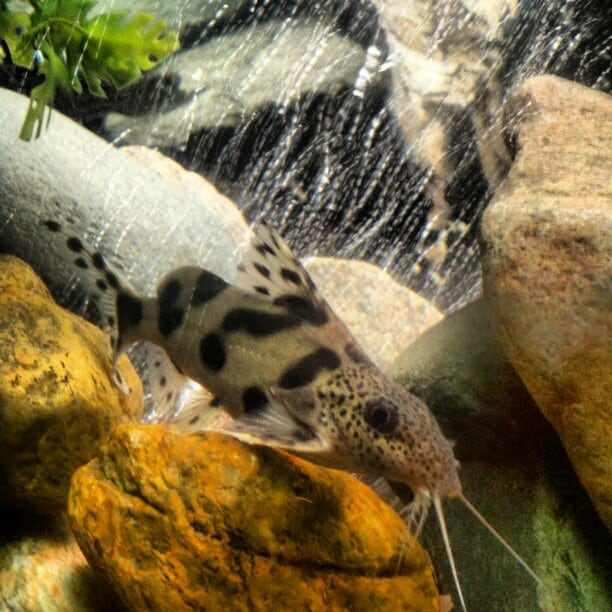
- Maximum size: 10 inches
- Minimum tank size: 50 gallons
- Minimum school size: 3
- Water temperature: From 75° to 82° Fahrenheit
- pH: 6.5 to 8.0
- Diet: Omnivore
- Breeding: Unknown
The Clown synodontis is also known as the Clown Squeaker. Although this catfish is peaceful, it will eat very small fish and can fall victim to fin nippers. That said, these attractive fishes do make a nice addition to a community tank.
In nature, the Clown Squeaker eats small fishes, crustaceans, invertebrates, and some plant matter. These fish are nocturnal and should be fed at night to ensure that they receive their share of food in a community setup. In captivity, these fish will accept catfish tablets, pellets, flakes, frozen meaty foods, and live food. However, you should not feed worms to synodontis.
Alberti or “Bigeye Squeaker” Catfish (Synodontis alberti)
- Maximum size: 8 inches
- Minimum tank size: 55 gallons
- Minimum school size: 3
- Water temperature: From 73° to 81° Fahrenheit
- pH: 6.5 to 8.0
- Diet: Omnivore
- Breeding: Unknown
The Alberti is one of the hardiest of the synodontids, making it a good choice for a beginner.
These fish have some of the longest whiskers in the group, and the largest eyes, too. Both of these features are essential for these fish, as they are both nocturnal and predatory. Although they do venture out during the daytime, Bigeye Squeakers shy away from bright lights, so I recommend that you use floating plants to diffuse the light in your tank.
Unlike its relative, the Clown synodontis, the Alberti is shy and doesn’t do well when kept with aggressive cichlid species. Instead, choose smaller, peaceful fish that live in the middle to upper parts of the water column. Also, make sure that the tank is densely planted with lots of hiding places, caves, and overhangs.
3. Plecostomus
Belonging to the Loricariidea family, Plecos come from various parts of South America, including the Amazon River, Rio Xingu, and Rio Negro in Brazil.
In nature, Plecos prefer fast-flowing, well-oxygenated water with a rocky substrate. In the aquarium, plenty of driftwood is essential, as some species of Plecos rasp off a layer of wood with their sucker mouths.
Bristlenose Pleco (Ancistrus cirrhosus)
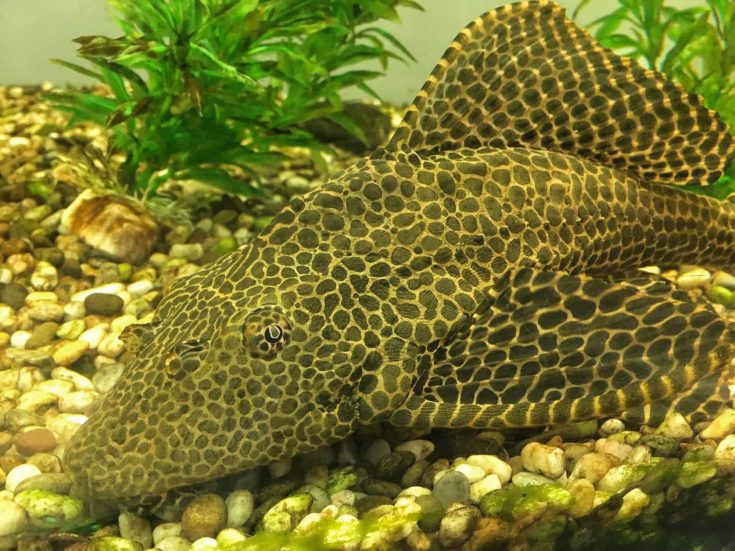
- Maximum size: 5 inches
- Minimum tank size: 40 gallons
- Minimum school size: 3
- Water temperature: From 72° to 86° Fahrenheit
- pH: 6.0 to 7.0
- Diet: Herbivore
- Breeding: Egg layers
Bristlenose plecos are a much more suitable option for the aquarium than the much larger Common pleco, typically reaching only five inches in length.
These fish cannot easily be mistaken thanks to the sensory organs that protrude like tentacles from the creature’s face. Female Bristlenose plecos only have bristles around their mouths, whereas males have more luxuriant bristles that cover most of the fish’s face.
Bristlenose plecos are peaceable characters that are a good fit for a community setup. Make sure that you include lots of caves, driftwood, rocks, and overhangs where the fish can shelter when they want to.
Clown Pleco
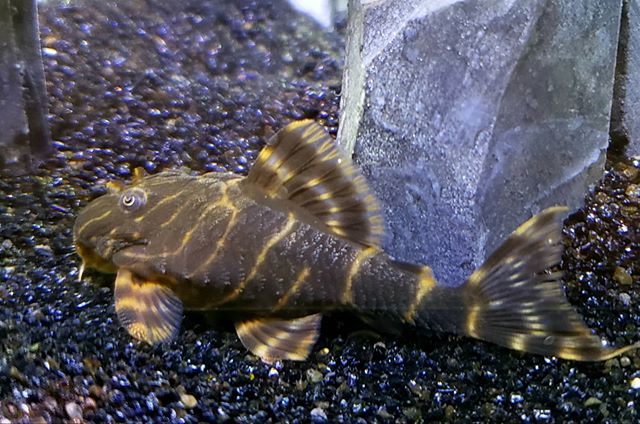
- Maximum size: 3.5 inches
- Minimum tank size: 20 gallons
- Minimum school size: 3 (Don’t have 2 males in one tank)
- Water temperature: From 73° to 82° Fahrenheit
- pH: 6.8 to 7.6
- Diet: Omnivore
- Breeding: Egg layers
The Clown pleco is easy to care for and suitable for beginners. These appealing fish are found mainly in Venezuela, although they have been recorded in Colombia, too.
If you take on a Clown pleco, you can expect to enjoy between ten and 12 years with your pet, provided you give it correct care and an appropriate diet. A pleco tank should have lots of driftwood, twisted roots, and other wood, together with a few flat stones and plenty of planting. Driftwood is extremely important in the habitat, as plecos feed on it to gain vital nutrients.
Golden Nugget Plecostomus (Baryancistrus xanthellus)
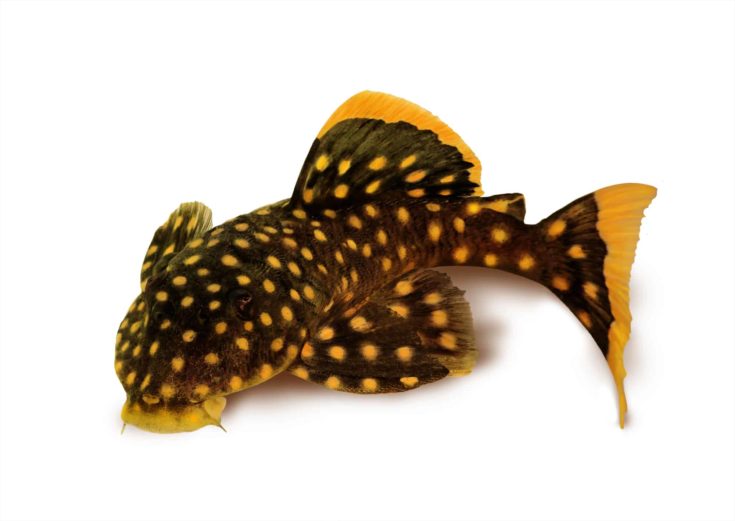
- Maximum size: 14 inches
- Minimum tank size: 100+ gallons
- Minimum school size: Solitary
- Water temperature: From 77° to 86° Fahrenheit
- pH: 6.5 to 7.5
- Diet: Omnivore
- Breeding: Egg layers
For a truly beautiful and unusual addition to your tank, you might want to take on a Golden Nugget Pleco. There are three different varieties of these fish; L018, L081, and L177, all of which originate from several locations along the Rio Xingu in the Amazon. All of these Golden Nugget variants can be bought online, and sometimes you’ll find one in a fish store, although they are very expensive compared to other pleco types.
In the aquarium, you’ll need to replicate a South American river habitat with a fairly strong water flow, lots of wood, rocks, hiding places, and dense planting.
For safety’s sake, we recommend that you have just one of these beautiful catfish in your collection and avoid housing other bottom-dwellers in the same setup.
Royal Panaque (Panaque nigrolineatus)
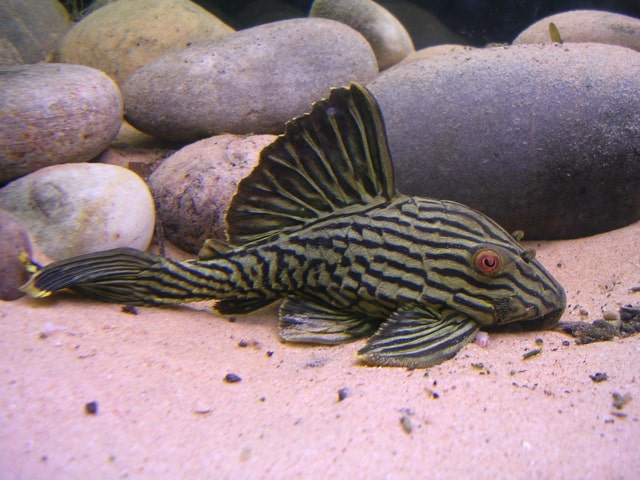
- Maximum size: 14 inches
- Minimum tank size: 150+ gallons
- Minimum school size: Solitary
- Water temperature: From 72° to 86° Fahrenheit
- pH: 6.0 to 7.0
- Diet: Herbivore
- Breeding: Egg layers
The Royal Panaques is also called the Royal pleco and is a truly beautiful and unusual variety of pleco. The gorgeous blue-green color of the fish certainly draws the eye when you have one of these guys in your display tank.
Although the Royal pleco is fine when housed with fish species that live in the middle to upper areas of the tank, these fish can be territorial and belligerent with other bottom-dwellers, and it’s not recommended that you keep two of these fish together as they will probably fight.
Other Popular Aquarium Catfish
Here are a few more of the most popular aquarium catfish species that thrive in a well-maintained home tank.
4. Pictus Catfish
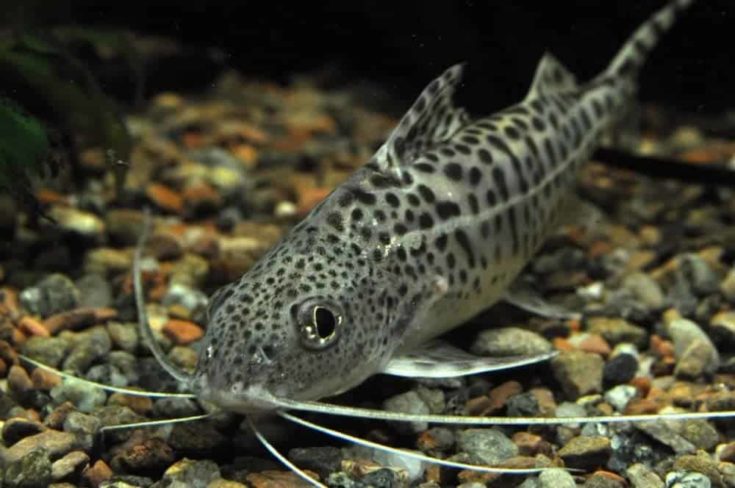
- Maximum size: 6 inches
- Minimum tank size: 55+ gallons
- Minimum school size: 3 to 4 but can be kept alone too
- Water temperature: From 72° to 78° Fahrenheit
- pH: 7.0
- Diet: Herbivore
- Breeding: Egg layers
Pictus catfish come from South America where they’re found schooling in rivers with sandy substrate and a good flow. Although they’re quite small, these fish need a decent sized tank, as they are very active swimmers.
Although you can keep one specimen in a 55-gallon tank, ideally a small school is better but you will need a larger tank of 100 to 200 gallons. A moderate water flow is preferred with a soft, sandy substrate, plenty of hiding places, and thick planting. These sensitive, scaleless fish do produce quite a lot of waste and they don’t do well in unhygienic conditions, so you will need a decent filtration system to keep the water clean.
5. Upside-Down Catfish (Synodontis nigriven)
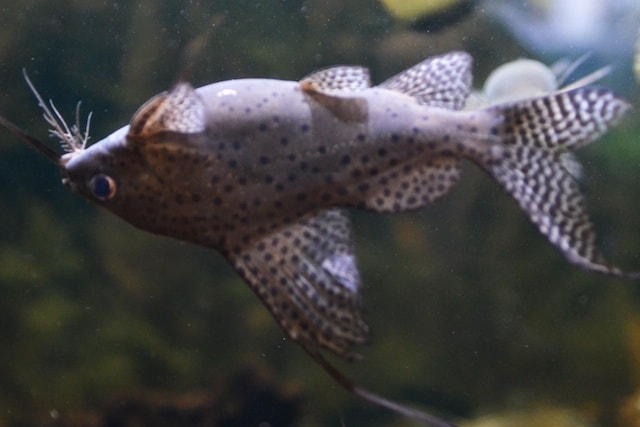
- Maximum size: 4 inches
- Minimum tank size: 55+ gallons
- Minimum school size: 3 to 4
- Water temperature: From 71° to 79° Fahrenheit
- pH: 6.5 to 7.2
- Diet: Omnivore
- Breeding: Egg layers
The Upside-down catfish is an extremely unusual fish that has the amazing ability to swim upside down to more easily access food on the water surface or on the underside of rocks, wood, and the like.
This species was first described in 1936 and was first exported in 1950 when it caused something of a stir in the hobby. Upside-down catfish prefer to be kept in small groups, interacting peacefully with each other.
The fish are easy to feed in captivity, enjoying live food, tablet foods, flake, and frozen bloodworm and daphnia.
6. Glass Catfish (Kryptopterus minor)
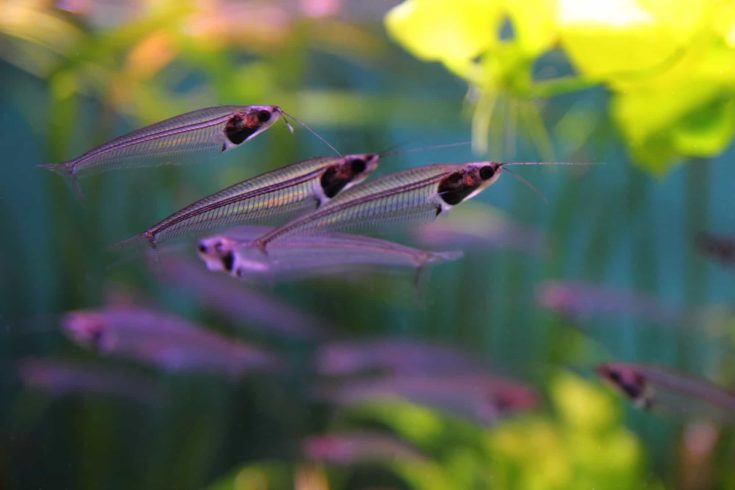
- Maximum size: 4 inches
- Minimum tank size: 30 gallons
- Minimum school size: 5
- Water temperature: From 72° to 82° Fahrenheit
- pH: 6.0 to 7.0
- Diet: Omnivore
- Breeding: Egg layers
The Glass catfish is often labeled as the Ghost catfish in fish stores. It’s easy to see where the fish gets its name! The creature’s glass-like body is transparent, allowing you to see the fish’s spine. Another peculiarity of this catfish is that it doesn’t have an obvious dorsal fin.
These stunning fish are extremely sensitive to water parameters and should not be added to immature tanks. The fish come from fast-flowing streams in Southern Asia and need a medium to high flow in the tank. You also need to provide plenty of cover in the form of dense planting to give this shy species confidence and make them feel secure and stress-free.
7. Bumblebee Catfish (Microglanis ihering
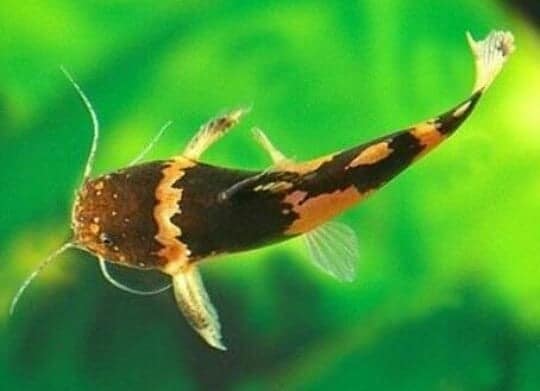
- Maximum size: 3 inches
- Minimum tank size: 20 gallons
- Minimum school size: 3
- Water temperature: From 70° to 77° Fahrenheit
- pH: 6.5 to 7.5
- Diet: Omnivore
- Breeding: Unknown in captivity
The Bumblebee catfish comes from South America, mainly Venezuela and Colombia, although it’s also found in parts of northern Brazil, Ecuador, and Guyana. The natural habitats of this peaceful, cute fish are streams and rivers where the current is fast-flowing and the substrate is rocky with plenty of hiding places.
The fish was first documented in the early 1900s, but it was quickly adopted as a popular aquarium inhabitant among early hobbyists.
Bumblebee catfish make a nice addition to a community tank, as they are non-aggressive and mix well with most other fish species.
8. Otocinclus Catfish
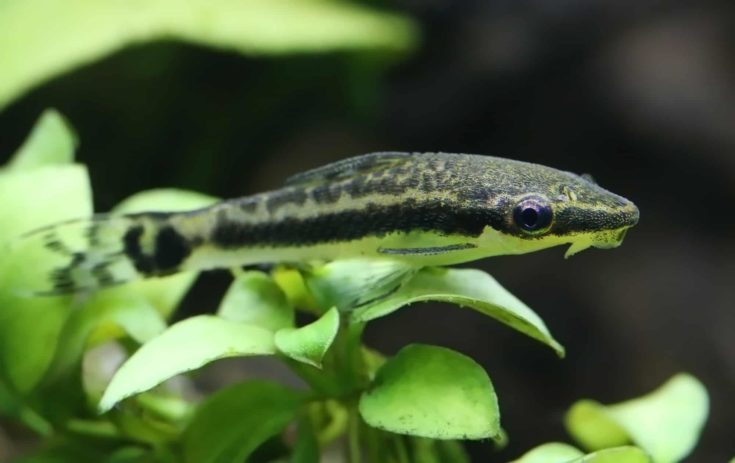
- Maximum size: 1.5 to 2 inches
- Minimum tank size: 20 gallons
- Minimum school size: 3 to 5
- Water temperature: From 72° to 82° Fahrenheit
- pH: 6.0 to 7.5
- Diet: Herbivore
- Breeding: Egg layers
Otocinclus catfish are popular with aquarists as voracious algae eaters. Algae comprise most of the fishes’ diet, so you will need a good supply of the green stuff in your tank to prevent the fish from starving. You can also feed blanched veggies and algae wafers, which make a valuable addition to the fishes’ diet.
These peaceful little catfish spend much of their day grazing on algae with their sucker-like mouths or darting around the bottom of the tank in a small school. You can keep Otocinclus in a community setup, as they get along well with other non-aggressive fish species.
9. Asian Stone Catfish (Hara jerdoni)
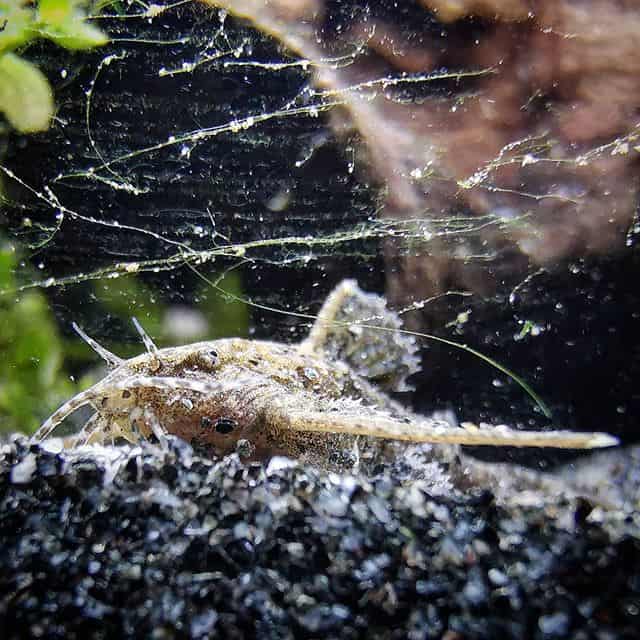
- Maximum size: 1 inch
- Minimum tank size: 15 gallons
- Minimum school size: 3 to 5
- Water temperature: From 72° to 78° Fahrenheit
- pH: 6.0 to 7.2
- Diet: Omnivore
- Breeding: Egg layers
Asian Stone catfish are small and relatively inactive, making them a great choice for a nano tank. These catfish are extremely shy spending much of their time hiding during the daylight hours and venturing out at night to feed. You can help the fish to be more confident by keeping them in small groups and ensuring that other members of the community are small and peaceful.
Stone cats are sensitive to water conditions, so you’ll need a clean, well-filtered tank where the water parameters remain stable. These fish love a heavily planted tank with plenty of low-light plants and a soft, sandy substrate.
10. Striped Raphael Catfish (Platydoras armatulus)
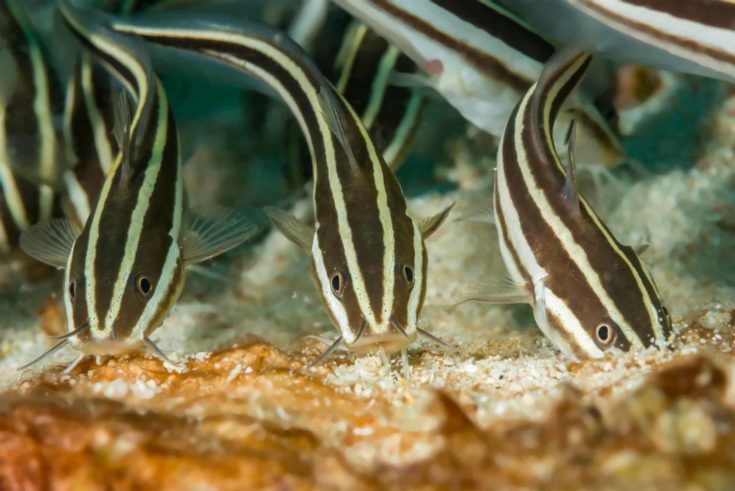
- Maximum size: 7.9 inches
- Minimum tank size: 30 gallons
- Minimum school size: 3 to 5
- Water temperature: From 75° to 78° Fahrenheit
- pH: 6.0 to 8.0
- Diet: Omnivore
- Breeding: Egg layers
The Striped Raphael catfish is found right across South America where it lives in slow waters, bogs, and streams throughout the Orinoco and Amazon river basins. These shy catfish hide among submerged roots and dense vegetation, feeding on detritus, mussels, and small crustaceans.
In the aquarium, you should use a soft, sandy substrate, as the catfish bury themselves if they feel threatened. Although the Striped Raphael catfish is territorial, they can be kept in a community tank with larger fish and do well in same-species groups. These catfish are primarily nocturnal, so be sure to turn off your tank lights at feeding times.
You might be interested in our article about spotted Raphael catfish.
11. Chinese Algae Eater (Gyrinocheilus aymonieri)
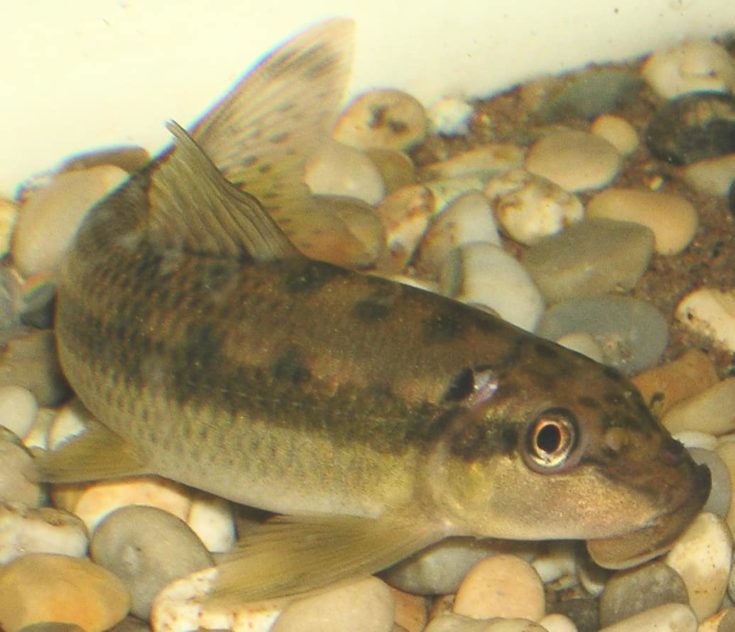
- Maximum size: 5 inches
- Minimum tank size: 50 gallons
- Minimum school size: Solitary
- Water temperature: From 75° to 80° Fahrenheit
- pH: 5.8 to 8.0
- Diet: Herbivore
- Breeding: Egg layers
Chinese Algae Eaters generally prefer a solitary life, keeping away from other fish, including their own species. In the tank, it’s best to keep just one of these catfish, as they can become aggressive, especially toward fish of a similar size or appearance.
These fish are easy to care for and they do make an excellent addition to a tropical freshwater tank, as they spend most of their time grazing on algae.
The Chinese Algae Eater comes from large areas of southeast Asia, where it lives in large rivers, spending much of its time clinging to flat rocks with its sucker mouth.
12. Twig Catfish (Farlowella acus)
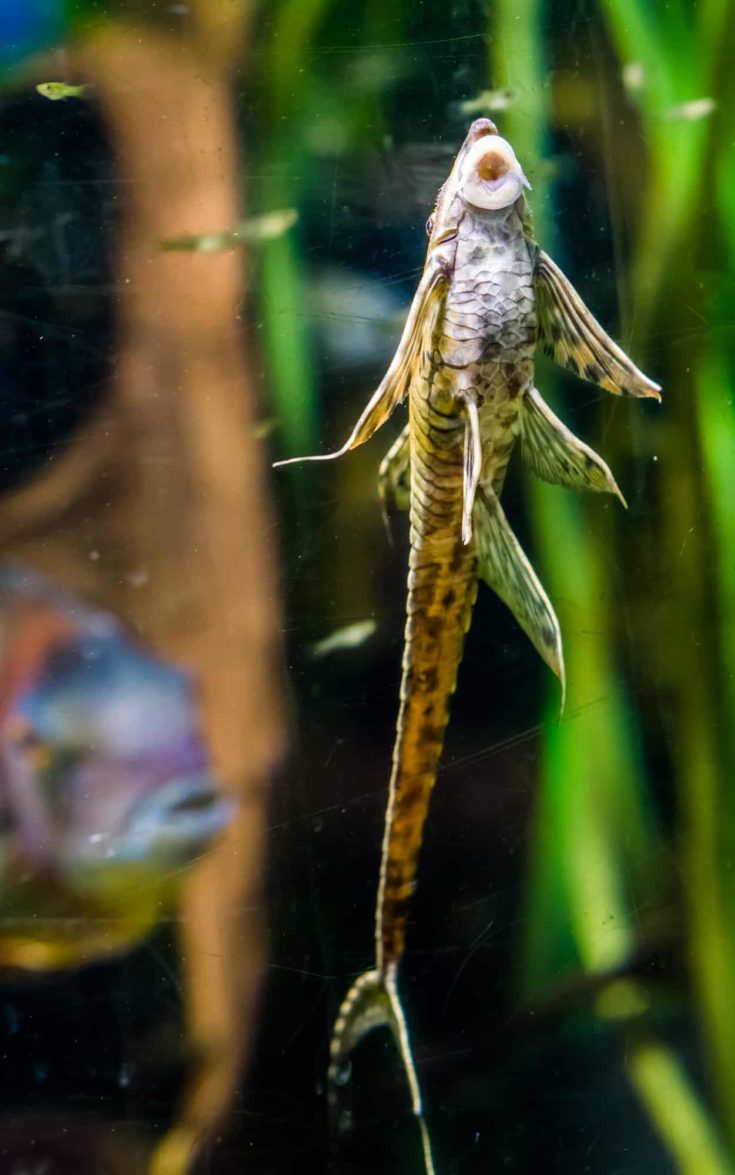
- Maximum size: 9 inches
- Minimum tank size: 20 gallons
- Minimum school size: 3 to 5
- Water temperature: From 75° to 79° Fahrenheit
- pH: 6.0 to 7.0
- Diet: Mainly herbivore
- Breeding: Unknown
Although there are around 37 species of Twig catfish, only two are kept as aquarium specimens; Farlowella acus and Farlowella vittata. However, you’re unlikely to see F. acus for sale in fish stores because it is endangered in the wild.
The fish come from South America, specifically from the Orinoco, Amazon, and Paraná rivers, where the habitat is flooded and heavily vegetated and littered with submerged tree branches and roots.
These are timid fish that can be kept in large groups of the same species, although they don’t do well in community tanks where they are often outcompeted for food.
13. Tiger Shovelnose Catfish (Pseudoplatystoma fasciatum)
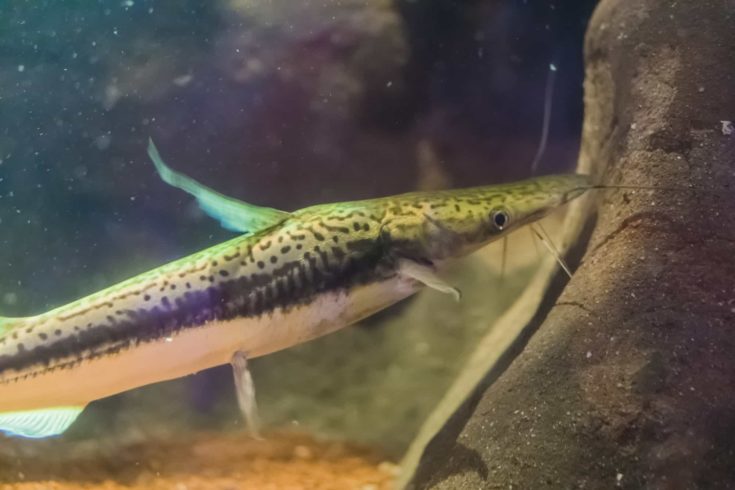
- Maximum size: 2 to 3 feet
- Minimum tank size: Over 200 gallons
- Minimum school size: Solitary
- Water temperature: From 75° to 82° Fahrenheit
- pH: 6.0 to 7.0
- Diet: Omnivore
- Breeding: Not in captivity
Tiger Shovelnose catfish come from rivers in South America where these predatory fish can grow up to four feet in length. These catfish are aggressive ambush hunters and are not suitable for life in a community tank unless you keep them very well fed so that they don’t feel the need to eat their tankmates.
In the wild, these catfish are often caught for food but can survive for up to 23 years. So, if you take on one of these giants, you can expect a long-term commitment!
These are highly active fish, swimming boisterously in all areas of the tank, and they jump too, so you’ll need a huge tank with a very tightly fitted lid if you want to keep one of these giants.
Catfish Species To Avoid
There are a couple of catfish species that are best avoided:
14. Common Pleco (Hypostomus plecostomus)
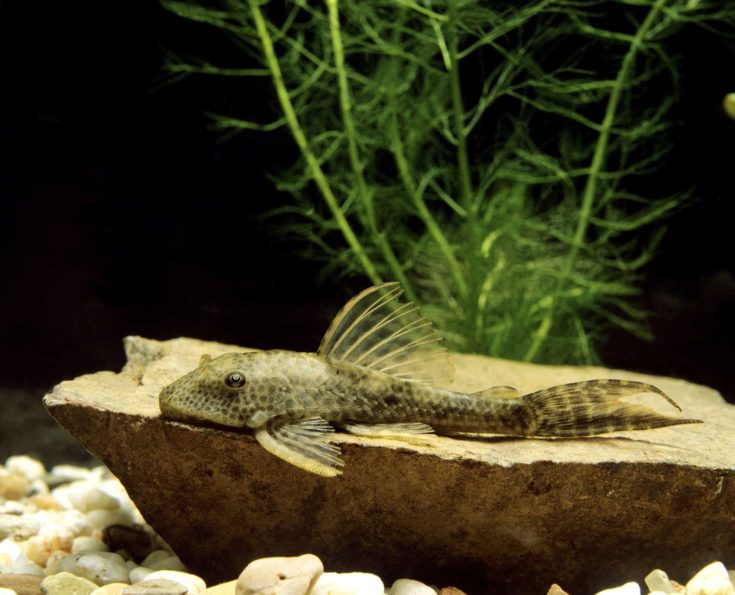
- Maximum size: 12 inches
- Minimum tank size: 75 gallons
- Minimum school size: Solitary
- Water temperature: From 75° to 82° Fahrenheit
- pH: 7.0 to 8.0
- Diet: Omnivore
- Breeding: Not in captivity
Common plecos are very popular aquarium fish that people buy without realizing how large and how quickly the fish will grow. Also, plecos are not exclusively algae eaters, which is why most hobbyists buy one. These fish are omnivores, and won’t be interested in algae once they realize that other food is on the menu.
Common plecos that have outgrown their tank are often released into the wild by their owners, where the fish can cause chaos by outcompeting native wildlife for food.
15. Redtail Catfish (Phractocephalus hemioliopterus)
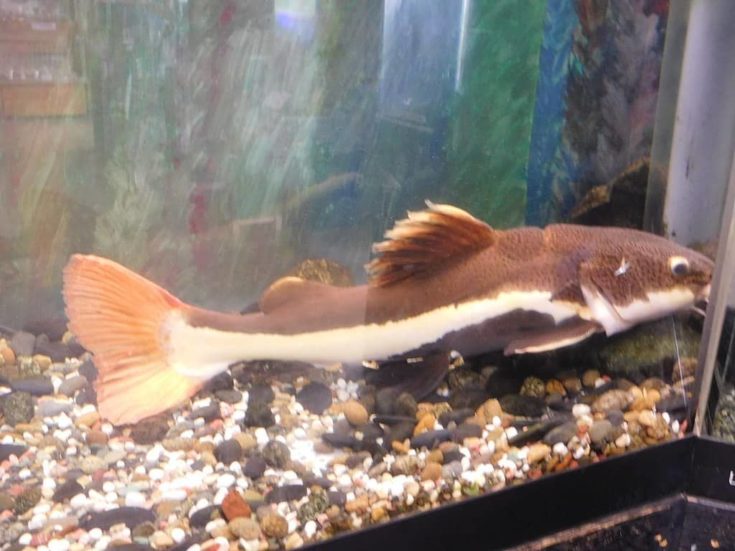
- Maximum size: 4 to 6 feet
- Minimum tank size: 1,000 gallons
- Minimum school size: Solitary
- Water temperature: From 68° to 79° Fahrenheit
- pH: 6.0 to 7.5
- Diet: Carnivore
- Breeding: Not in captivity
The Redtail catfish is not suitable for life in an aquarium, although juvenile specimens are sometimes sold in fish stores.
These fish grow to a massive size, and are highly aggressive, carnivorous predators. So, unless you have a specialist tank and experience in keeping similar fish species, a Redtail catfish is not for you.
How to Choose Catfish for Your Aquarium
There are over 2,000 different species of tropical freshwater catfish, and most people are familiar with the huge specimens that are often caught by anglers as trophy fish or for the table. But did you know that many smaller catfish species are suitable for life in the home aquarium?
All catfish have their own peculiarities and characteristics. However, as a group, catfish have one similarity in that none of them have scales. Instead, catfish are covered with an armor-like plating. Catfish are pretty long-lived as aquarium fish species go, surviving for seven to 15 years if given the correct care.
In this part of our guide, we show you what kind of ornamental catfish species might suit your tank.
Tank Size
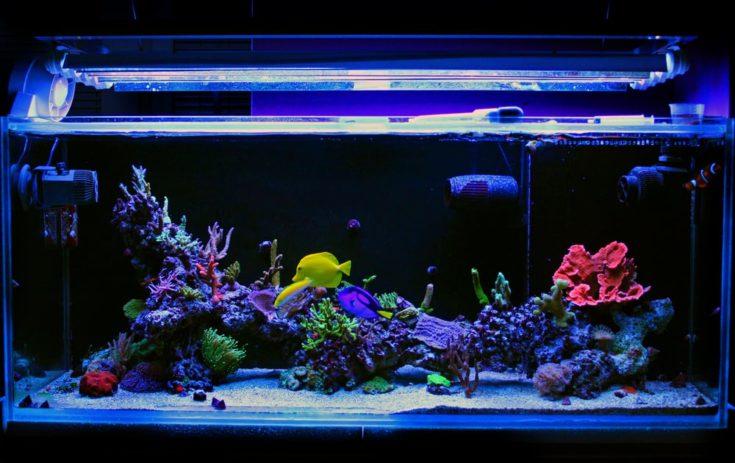
As with all types of aquarium fish, you must know how big your chosen fish will grow. Some catfish species may start life in your tank as cute little creatures of just a few inches in length but then quickly grow alarmingly to reach a foot long or even more at maturity.
Remember that the general rule of thumb for stocking your aquarium is to allow one gallon of water per one inch of fish. So, be sure to find out how large your chosen catfish will become and factor that in when working out if your tank is big enough. It’s an urban myth that the fishes’ size is determined by the size of the aquarium in which they live. Big fish simply keep on growing until they’re too big for their tank.
Unlike most other fish species that cruise the middle and upper regions of the water column, catfish are bottom-dwellers, spending much of their time exploring and foraging around the substrate. Adding a few catfish to your tank can help to provide added interest to a part of the aquarium that’s often neglected. To ensure that the catfish have plenty of space to roam, choose a tank that’s longer than it is tall.
Tankmates
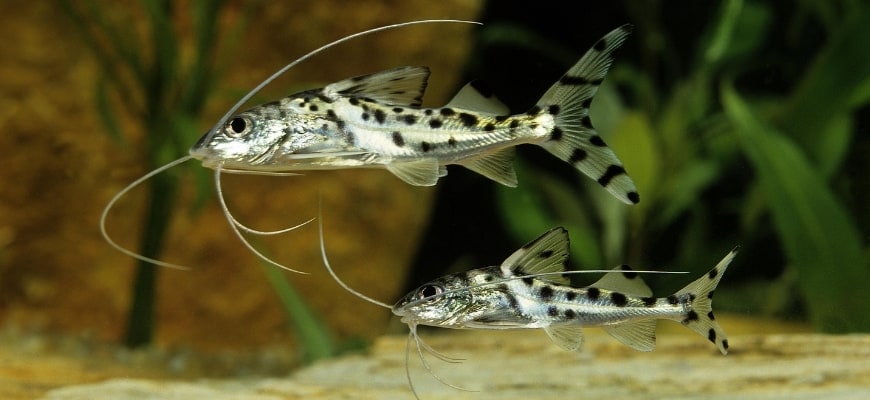
Most catfish are peaceful, although some species can be territorial. As catfish inhabit the bottom of the tank, they are unlikely to come into contact with other members of the community that gravitate toward the upper areas of the water column.
An important point to note is that many species of small aquarium catfish are schooling fish that must be kept in small groups. For example, in nature, the tiny Pygmy Corydoras catfish lives in huge shoals several hundred strong.
However, some larger species of predatory catfish will prey on tiny fish and invertebrates, so be sure to check the catfish’s profile before you buy.
Behavior
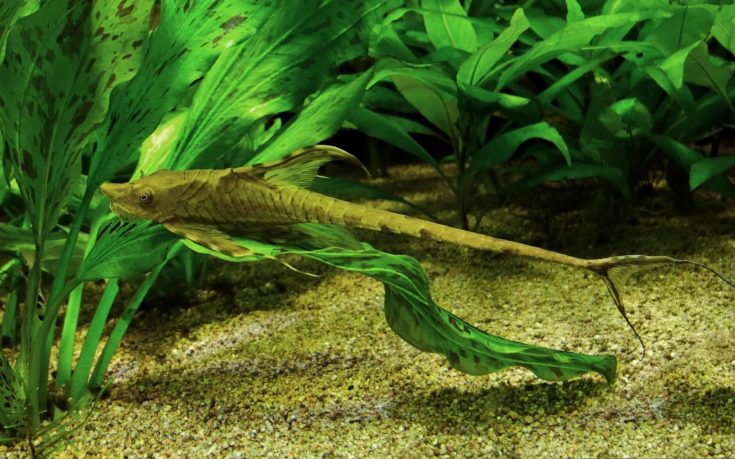
Most species of catfish that are kept in the aquarium are peaceable creatures that spend most of their time in small groups, foraging through the substrate or hiding amid plants and items of tank décor.
However, there are a few species that can be territorial and aggressive, so be sure to do your research before you choose catfish for your community tank.
Also, many catfish species are naturally nocturnal. That means you probably won’t see much of them during the daytime, and they must be fed after dark, too.
Tank Setup
Filtration
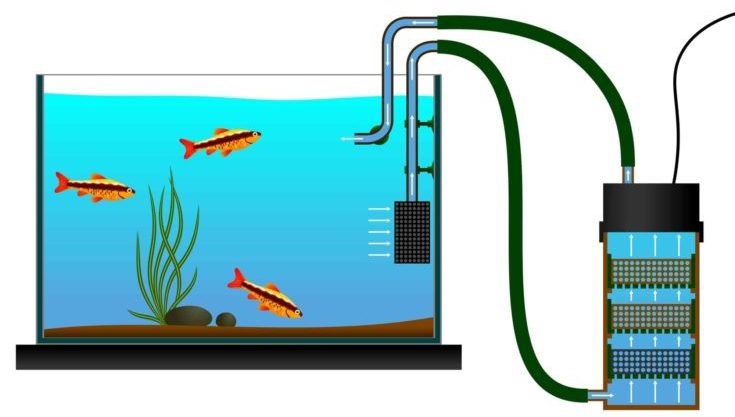
Catfish produce just as much waste as other fish, so you will need an external power or canister filter for larger species.
Many catfish species live in fast-flowing rivers, even inhabiting river rapids, so a strong flow shouldn’t cause a problem. One important thing to note is that no catfish appreciates a new tank, so always cycle your setup properly before introducing your new fish.
Tank Décor
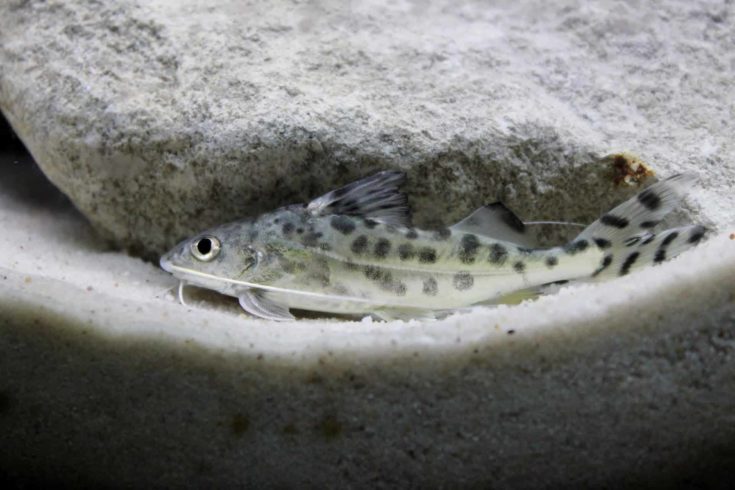
Most catfish have delicate barbels, whiskers, and scaleless skin that can leave them vulnerable to injury. So, a fine, sandy substrate is the best choice.
Catfish love to hide, especially during the daytime. You must also provide caves, overhangs, large rocks, and twisted roots that replicate the fishes’ natural habitat. Interestingly, the more hiding places you provide, the more likely it is that you’ll see your catfish during the day, as they will feel safe enough to venture out to explore.
Plants are an important addition that catfish enjoy. Floating plants can filter out bright light, helping to create dappled shade that the fish love.
When choosing décor for your tank, always be mindful that the catfish need space to roam, so be careful not to clutter the aquarium’s bottom.
How to Take Care of Aquarium Catfish
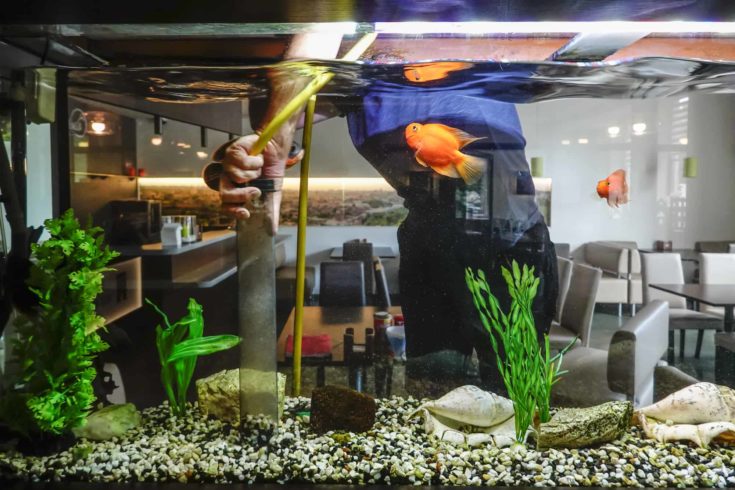
Contrary to popular belief, catfish need the same clean environment and stable water conditions as other fish species to remain healthy and happy.
Carry out weekly partial water changes, vacuum the substrate to remove excess waste, maintain your filtration system properly, and your catfish will be happy and thrive.
What to Feed Aquarium Catfish
Different catfish species feed in different ways, and you can tell how they feed by the shape of their mouths and whiskers.
For example, suckermouth plecos rasp algae from hard surfaces, ingesting wood, and grazing on bloodworms, vegetable matter, and fruit. Catfish with barbels are adapted to feel for invertebrates among the substrate, whereas those with wide mouths and very long barbels are predators that need a meaty diet.
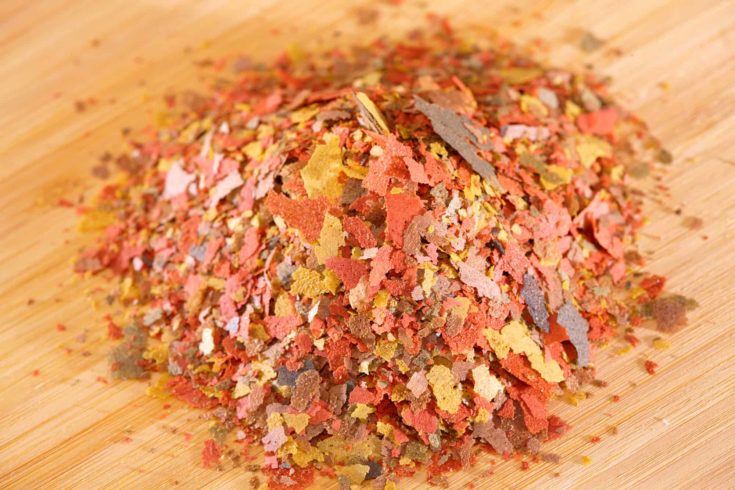
However, in general, a diet of high-quality fish flakes, sinking pellets, and live and frozen meaty foods will be fine for most catfish. If you keep suckermouth plecos, you’ll also need to allow a small amount of algae to grow on which the plecos can feed.
In Conclusion
We hope you enjoyed our guide to aquarium catfish and found it helpful. Now, it’s time for you to vote for your favorite fish by ticking the appropriate species below!
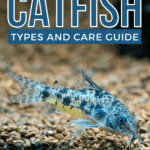
Why is the cuckoo catfish not mentioned when it’s one of these species that are very often sold for aquariums?